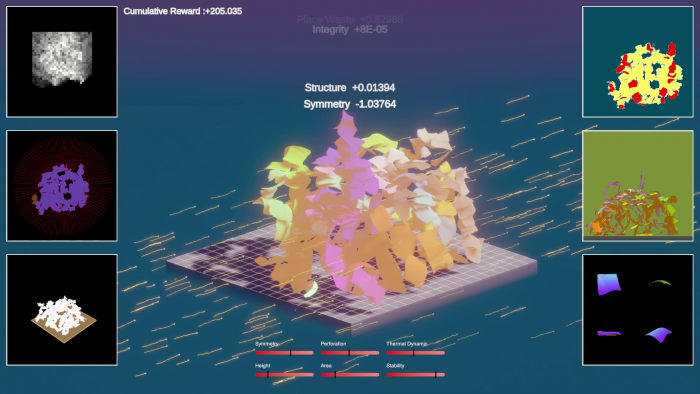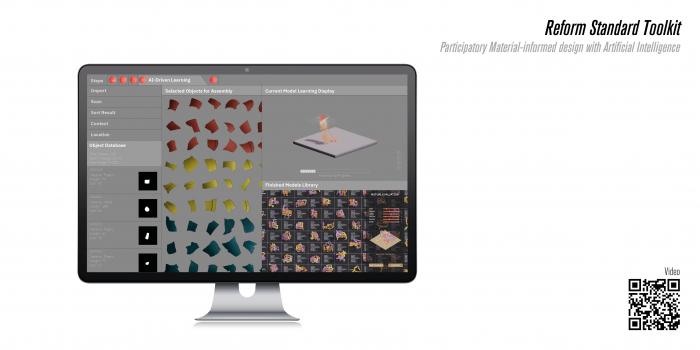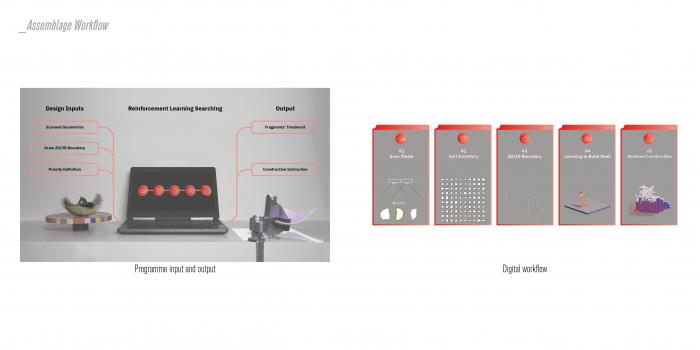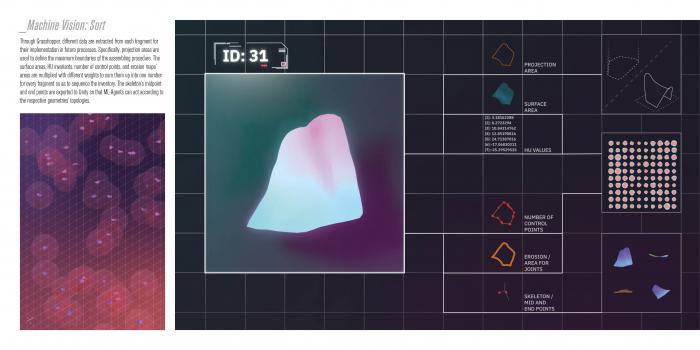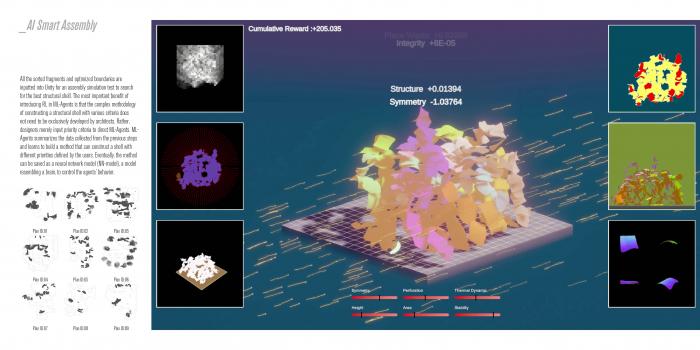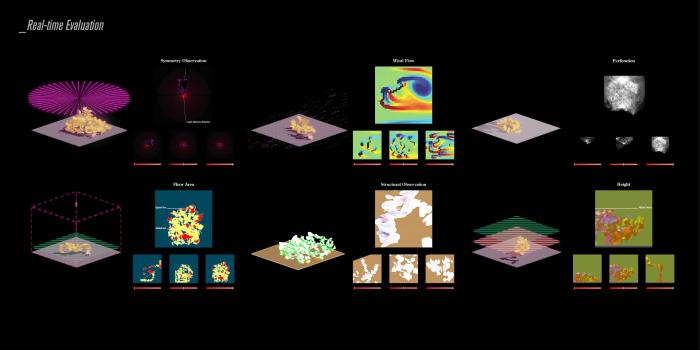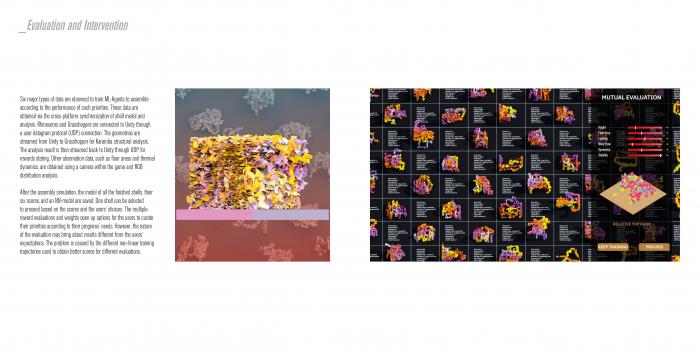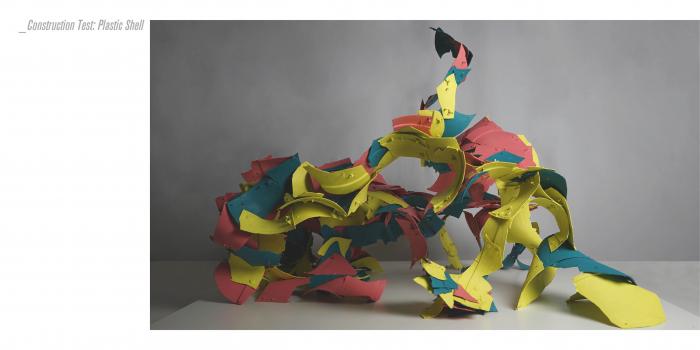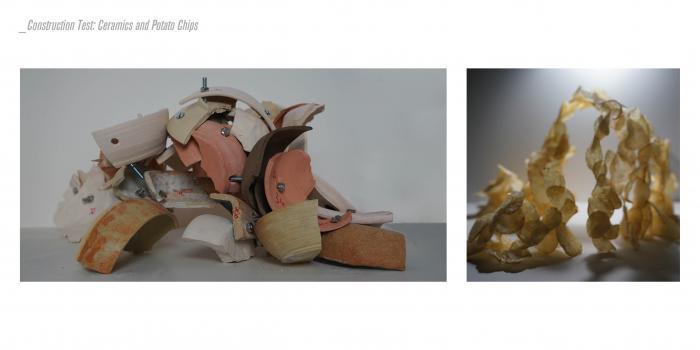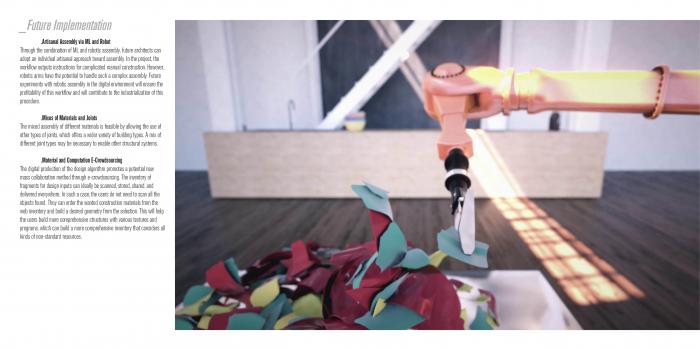I. SUMMARY INFORMATION
Project
267686
Status
Submitted
Award category
Techniques, materials and processes for construction and design
You want to submit
NEW EUROPEAN BAUHAUS RISING STARS : concepts or ideas submitted by young talents (aged 30 or less)
Project title
Reform Standard Toolkit
Full concept/idea title
Participatory Material-informed design via Artificial Intelligence
Description
Reform Standard is a machine-learning-driven searching program that designs new structures generated from existing non-standard materials to achieve complete circular economy. Using reinforcement learning, machine vision and automated searching process, the project aims to promote a material-informed design circle and converts wastes and non-standard materials into potential design and fabrication resources.
Where is your concept/idea being developed or intended to be implemented in the EU?
Austria
Vienna
Oskar-Kokoschka-Platz 2
Vienna
1010
II. DESCRIPTION OF THE PROJECT
Please provide a summary of your concept/ idea
Reform Standard is a program that invents an alternative design workflow for architectural design industry that achieves a complete circular economy. Using reinforcement learning, machine vision and automated searching process, the program inaugurates a material-informed design circle and converts wastes into potential design resources.
The project starts with questioning the problematic standardization that is widely practised in all industries. Standardization brings significant benefits to social and economic value with its organizational efficiency. However, it also generates increasing wastes and wasteland due to its one-way process that takes homogeneous inputs and processes. Reform Standard argues that an alternative level of flexibility in standardization – or a counter-process, “de-standardization” - through AI and capacity of computers’ searching power, will eventually revalue/objectify waste and redefine the notion of wasteland. Such an approach challenges the standardization of industries, production and design processes. With such an approach, architectural design can be informed by the material input at the beginning of design, which brings the potential to a better economic cycle and social value with more context-specific. The notion of wastes and wasteland in the future world could then be redefined as new natural land to be explored, designed and occupied by inhabitants and economic entities. The project sorts and transforms irregular chunks of wasted broken plastics into a new form. Instead of recycling those wastes in an energy-intensive process, the engine is finding the intricacy and new machine-oriented aesthetics in those otherwise neglected wastes.
Reform Standard utilizes processes of scanning, sorting inventory and structure generation. It not only revitalises waste materials’ lifecycles but also develops a more sustainable way of design that fundamentally changes the way we experience and evaluate a space.
Please give information about the key objectives of your concept/idea in terms of sustainability and how these would be met
The project achieves sustainability by enabling a designer to integrate complex geometries into their design workflow and thus promote a circular economy in industries. The toolset provides designers both an articulation methodology and information to achieve sustainability:
Enabling Reuse Over Recycle: Instead of an energy-intensive process in recycling a significant amount of construction wastes such as concrete rubble, metal and wood, the program enables the direct use and design of waste materials consist of various geometries. Designers no longer need to articulate their design from a standard panel, but they can inform the form which can be assembled with various non-standard materials through AI.
Augment Holistic View of Circular Economy: With the ability to include various waste and naturally found material with minimum editing, designers can thus obtain a bigger picture of the production cycle and reinforce a more sustainable construction cycle.
Please give information about the key objectives of your concept/idea in terms of aesthetics and quality of experience beyond functionality and how these would be met
Through the ways how it approaches a design, the quality of the realized space is radically changed by new materials and ways of collaboration:
New Material Intricacy: The new composition of material through non-standard process brings intricacy of human experience through new material appearance and composition. The building components such as a wall, column, floor, etc. are mixed, redefined, and with high resolution which reacts to customers’ demands, environmental evaluation and materials availability.
New Machine-augmented Aesthetic: A new machine-augmented aesthetic is justified by collaboration between both human and machine-filtered goals. This new aesthetic amplifies the intricacy of human experience that is also improved by machine perception as hidden logics.
Please give information about the key objectives of your concept/idea in terms of inclusion and how these would be been met
Through the further implementation of the project. The program will become more accessible to all types of targets including professionals and the public. In particular, the project will achieve:
Accessibility of Toolkit: The toolkit's workflow encourages collaboration and full accessibility among diverse disciplines, communities, professions and non-professions.
Comprehensive/More Material Choices: The program allows a more diverse choice of materials than conventional tools. The freedom to choose a wide range of materials makes design much more affordable and more efficient during the construction process.
Active Feedback Loop: Machine-oriented aesthetic and augmentation are actively interacting with users and designers to cover a more comprehensive evaluation including diversity and inclusion.
Please explain the innovative character of your concept/ idea
The concept inaugurates a new design workflow that promotes the reuse of wasted material (e.g., bent metals or plastic rubbles) and natural materials (e.g., bamboo) that are difficult to process. Therefore, the concept radically innovates the new design and build a workflow in three ways:
AI-driven Design Tool Implementation: Machine-learning-powered interface allows not only the profession but also the public to participate in design articulation which takes various demands and thus achieves a participatory design powered by collaboration among individuals and AI technology.
Architectural outcome: Possibility to achieve high-resolution construction guidance that manages to match all the above-mentioned demands, which redefines our conventional notions of wall, ceiling and floor to better accommodate users' activities and building programs. The outcome not only achieves a highly efficient organization but also presents new ideas that might be re-learned by architects due to the involvement of AI.
Material: Introduce both wasted material and materials that are hard to process in a standardized manufacturing process. This brings new possibilities for designers to innovate with a better-controlled budget.
Please detail the plans you have for the further development, promotion and/or implementation of your concept/idea, with a particular attention to the initiatives to be taken before May 2022
The ambition of the project is to inaugurate a new paradigm of architectural practice where the design process can be inverted via the tool, which then actively promotes sustainability and achieves a circular ecology in building construction and demolition industries. Thus, the major targets before May 2022 are :
Implementation:
Publishing the toolkit that contains a cloud server to host the design iteration, collect waste data and context analysis. The cloud service can be accessible to the public including both non-profession community participants and professional designers. Thus, we can further evaluate the design part of the toolkit from a larger audience.
Construction of a pavilion as a full-scale proof of concept through cooperation with local authorities, institutes, waste management groups and universities in Austria.
Development of the Toolkit:
Allowing online multiplayer accessibility to collaborate in a project.
Linking the fabrication method to the design outcomes. The fabrication-awareness can then be integrated as part of the AI-learning process to yield precise construction guidance.
Making the tool more friendly to non-professionals to allow more accessibility and evaluations. This requires further UX design and simplification of the tool.
Promotion for further evaluation:
Holding workshops at various platforms. The workshops will be held in various computer-aided architectural design conferences such as eCAADe, ACADIA, CAADRIA. A physical workshop can also be The promotion not only encourage professionals to engage in innovative sustainable design but also test the effectiveness of the toolkit.
Hosting an interactive website that presents the potential and results of the toolkit for discussion. The website is also actively promoting this particular sustainable workflow and collect information about potential material resources.
III. UPLOAD PICTURES
IV. VALIDATION
By ticking this box, you declare that all the information provided in this form is factually correct, that the proposed concept/idea has not been proposed for the New European Bauhaus Rising Stars Awards more than once in the same category.
Yes
